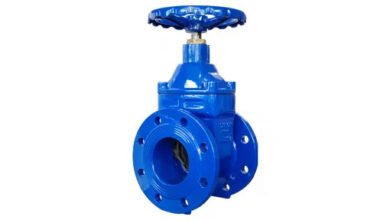The Most Underrated Pressure Reducing Valve

A Pressure Reducing Valve controls excess pressure to provide constant reduced pressure to a system. This valve is also known as a pressure reduction regulator. A pressure-reducing valve converts increased incoming pressure into lower outgoing pressure. They widely use in the water, steam, and oil and gas industries. Manufacturers of Pressure Reducing Valves define the valve as a self-acting automated control valve that reduces a greater uncontrolled intake pressure to a constant, lowered output pressure independent of upstream water pressure fluctuations. In this article, we will learn how pressure-reducing valves work, their types, uses, and benefits.
What is a Pressure Reducing Valve?
Pulsating high pressure in a fluid system causes maximum damage. As well, if the pressure is too high compared to what require for a system, it can lead to wastage of fluid (in domestic water systems), leakages over time as the system is designed to handle lower pressure, and it can even cause a pipe burst or system failure. Ultimately, all of this will contribute to a business’s higher operating costs and decrease the efficiency of the system.
A constant and reduced pressure supply in a fluid system can prevent this reduction in efficiency. An automatic pressure regulator or a pressure regulating valve can use to accomplish this.
Fluid systems use pressure regulating valves primarily to convert pulsating & high inlet pressures to constant & reduced (or preset) pressures.
Also, read “Types of Industrial Ball Valves & Designs”
What is the purpose of a Pressure Reducing Valve?
A pressure regulating valve opens when the pressure has to be reduced between two components of a process. By using these valves, liquid or gas pressure can be lowered to a predetermined level.
A pressure-reducing valve is a diaphragm-actuated, hydraulically powered control valve that lowers constant downstream pressure of varying upstream pressure. Despite harsh conditions, it designe to last. No matter how much flow there is, the valve maintains constant downstream pressure.
Fluid pressures acting over and under the piston, as well as spring force, determine the operation of pressure-reducing valves. When the low-pressure fluid and spring force exceed the high-pressure supply, the piston will close the valve. The piston opens the valve when the low-pressure fluid force is reduced and the new fluid pressure and spring force are less than the high-pressure supply fluid. To maintain pressure under control, the valve will open and close frequently. By changing the spring, the outlet pressure of the valve can be adjusted. An adjustable screw may be used to adjust the spring force in certain situations. The performance of some reducing valves can be improved by using several pistons and diaphragms.
There are several types of pressure-reducing valves.
According to the mechanism that controls the valve opening, pressure reduction valves can categorie into two main categories:
-
The direct-acting pressure-reducing valve
For lower pressures that do not require precise pressure control, direct-acting pressure reduction valves are excellent. Small in size, cheaper, and easy to set up, they are a good choice. Compared to their pilot-operated counterparts, they often fluctuate more from the set pressure. There are two basic types of pressure-reducing valves: flat diaphragm and bellows. It does not require an external sensing line downstream because it was self-containe.
An adjustment spring directly controls the amount of valve opening in a direct-acting pressure reduction valve. By compressing the spring, an adjusting screw creates an opening force on the valve, causing the flow to rise. Equalization occurs when downstream pressure transfer to the underside of the adjustment spring, where its upward force counterbalances the spring’s compression. To equalize with variations in downstream pressure, the spring compressive force opens the valve limit.
-
Pressure Reducing Valve Operated by Pilot
Often used for higher loads that require precise pressure control, pilot-operated pressure reducing valves use. As compared to direct-acting models, they are quicker to react to load fluctuations and can handle a wider range of flow rates. Their size and cost make them more expensive.
A pilot valve increases the downward force required to open a larger main valve in pilot-operated pressure-reducing valves by loading a piston or diaphragm. Similar to direct-acting valves, the pilot valve’s opening and closing control the balance of force between the adjustment spring and secondary pressure. A pilot-operated valve, on the other hand, opens and closes intentionally to supply pressure to the main valve piston or diaphragm. The pilot flow pressure generates a downward push, which is magnified the area of the piston or diaphragm, allowing a much larger main valve to open, allowing for extremely high flow rates. Aira Euro Automation is the leading pressure-reducing valve manufacturer in India.
When a piston or diaphragm employ, the downward force can be magnified by a minor change in pilot valve opening, resulting in a substantial change in flow and downstream pressure. As consequence, the adjustment spring force on the pilot only needs to adjust a little to achieve rapid reaction over a wide range of steam flow rates. Fast reaction and precise pressure control are the major advantages of this type of valve over direct-acting valves.
There two types of pilot operat pressure reducing valves:
A pressure reducing valve with an internal pilot, and
A pressure-reducing valve that external pilot.

Applications of pressure-reducing valves.
Water services, Air & Gas Services, Hydraulic systems, Steam services, Fuel oil systems in IC engines and boilers, etc., use these valves.
Both direct-acting and pilot-operated pressure reduction valves use in compressed air systems, power tools, pneumatic control systems, and control valves for industrial gas storage and distribution systems. The type of pressure-reducing valve used for these services depends on the level of control required.
Among water distribution systems and fire prevention systems, pressure-reducing valve widely use. Direct-acting pressure-reducing valves commonly recommend for these services. In high-demand situations, maintaining system pressure becomes extremely challenging. To regulate downstream pressure to an acceptable level, pressure reduction valves use.
The advantages of a pressure-reducing valve.
By doing so, it protects the pipelines and components of the system from hammering.
The valve does not require an external power source to operate.
It is very simple in design, requires very little maintenance, and is low cost.
A self-contained valve does not require separate measuring elements or controllers.
Pressure Reducing Valve Disadvantages.
A pressure-reducing valve can develop blockages that prevent the valve from opening or closing to maintain the desired pressure. Salt deposits or suspended solids in the fluid medium can cause this problem.
Since internal components expose to the system fluid, they are prone to damage over time.
The screw must adjust manually to set the pressure.
Choosing a Pressure Reducing Valve.
Choose a pressure-reducing valve that is durable, cost-effective, and of good quality.
First, choose between a piston sensing regulating valve or a diaphragm sensing regulating valve. Diaphragms have greater sensitivity and come in a variety of materials. Compared to diaphragm sensing regulators, piston valves are capable of high-pressure regulation but have less sensitivity.
Pressure regulator sizing: Any process engineer wants to select the smallest valve that can perform the function. Sometimes the smallest valve is the most affordable. However, you must understand the exact dimensions of the pipe. Inefficiencies and operational problems may result from choosing the incorrect size. To select the proper size, follow these steps:
Calculate the minimum and maximum system flow a valve can handle.
Determine the pressure differential between upstream and downstream.
Find the flow coefficient, C, using the following formula
Cv * (square root of pressure differential) = Flow (Q)
If you choose a valve with a slightly larger Cv than you calculated, you will be able to handle higher flows in the future.
Finally, ensure that the flow rate and pressure provided are appropriate and documented. Make accurate calculations over-informed approximations to achieve optimum efficiency.
Maintenance of Pressure Reducing Valve.
Consider the following points when performing maintenance on these valves.
- Check the pilot system for leaks or breaks.
- Make sure the strainer screen is clean and free of dirt.
- Remove any air pockets from the pilot valve.
- Make sure the main valve and pilot valve diaphragm not damage, and that they not leaking.
- Ensure that there is no blockage in the pilot line and that it is free-flowing.




